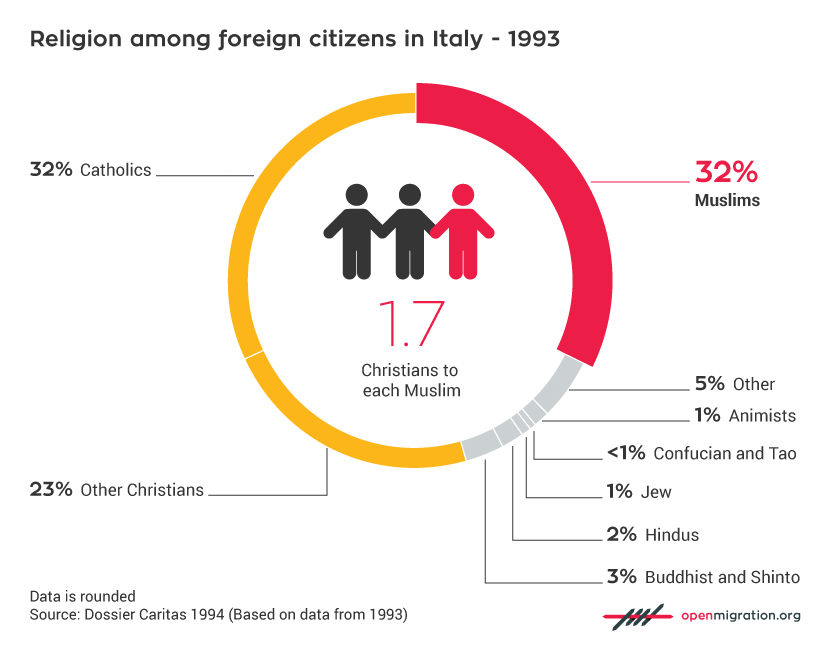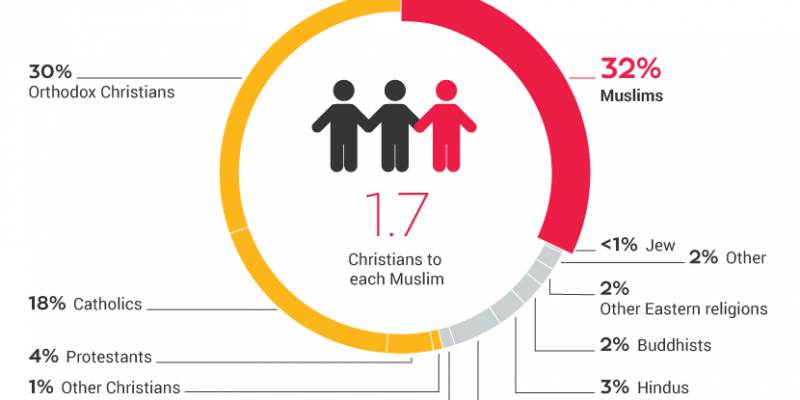
On October 6, 2015, Claudio Cartaldo wrote in Il Giornale:
There are several ways to stop the “invasion”. Some take political action, some call for an intervention by the army and many politicians promise to regulate migrations to avoid Europe becoming a Muslim continent. An ordinary parishioner in Codogne, near Treviso, has decided instead that the best way was to invoke the Virgin Mary. So he went to church and he made a donation to celebrate a mass “in honour of Our Lady of the Rosary, to stop the Muslim invasion of Italy and Europe”.
Analysis
If «there are several ways to stop the “invasion”», it must mean that the Islamic invasion exists, that it is an established fact. But is that really the case?
What is certain is that segments of the politicians, the media and the public opinion are convinced that it is. And they express it in two general ways. One on hand there is concern for the “purity” of Italian culture, leading to accusations that foreigners don’t know how to speak “our” language, to respect “our” traditions and so forth. On the other hand, there are fears that Muslims arriving in Italy may hide terrorists in their ranks.
Essentially, fear of the invader is linked to the issue of integration and, cyclically, to the issue of security.
Regardless of whether or not you find these concerns grounded, it is interesting to interrogate the data in order to verify if we are actually witnessing an invasion, both in terms of absolute figures and by comparison with past data.
In a country like Italy, which has only a recent history of migrations, most of which non-systematic, we took as a reference the aggregated data from the 1994 Caritas Statistical Yearbook.

There were 318.000 Muslims in Italy in 1993, a number only slightly higher to that of foreign Catholics. Therefore, on a total of 1 million foreign citizens (987.505, to be precise), about a third were professing the Islamic faith.
The situation hasn’t changed much in the subsequent twenty years, despite the geopolitical transformations and the changes in the makeup of migratory influxes. According to the last available census, conducted by IDOS in 2015, some interesting facts have emerged. For instance, the percentage of Catholics has decreased from 32 percent to 18 percent between 1993 and 2014. However, in the overall redistribution of foreign believers in Italy, the percentage of Muslims has not increased: it’s still at 32 percent, the same as twenty years ago.
But the most striking fact, on comparing current and past data, is the growth of the Orthodox Christian community, going from 222.000 in 1993 (which also include other non-Catholic denominations) to 1.520.000 in 2014, that is, from 23 to 30 percent. This spike can be explained with the increased migratory influx from Eastern Europe, particularly from Romania starting from 2007, when it became a part of the EU. According to an Istat study published in October 2015, Romanians account for 60 percent of all Orthodox Christians in Italy.

Further disproving the invasion myth, the statistical data on Italy show that, over a period of twenty years, Muslims have gone from 0.5 percent of the population to 2.6 percent. In the same years, the foreign community has gone from 1.7 percent of the population to 8.2 percent in 2014. This means that the growth of Muslim has been proportional to that of the total foreign population of Italy. There was no “Islamic invasion”.
Our opinion
The term “Islamic (or Muslim) invasion” is essentially inaccurate for two reasons. If by “invasion” we mean the sudden, massive influx of Muslims into a given territory, this is not what has happened because 1) over a period of twenty years, the proportion between Muslims and other foreigners in Italy has remained unchanged; 2) over the same period, the percentage of Muslim citizens in Italy has remained modest and lower than in the whole of Europe (6% as of 2010). For Muslims in Italy – as for every other religious faith – growth has been proportional to the (increasingly slower, in recent years) growth of the migrant population.
Twitter: @alessandrolanni









